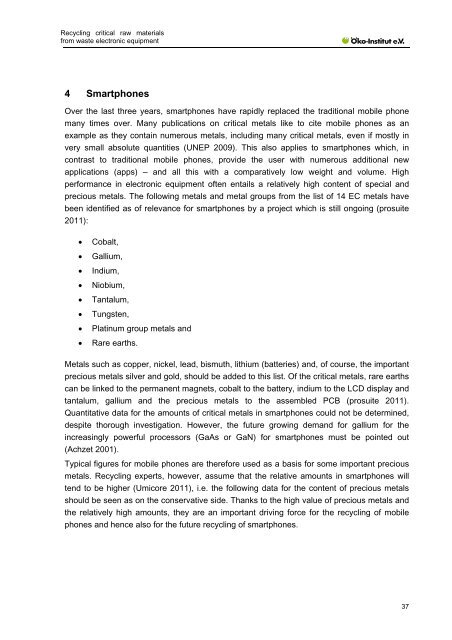Recycling critical raw materials from waste electronic equipment
Recycling critical raw materials from waste electronic equipment
Recycling critical raw materials from waste electronic equipment
You also want an ePaper? Increase the reach of your titles
YUMPU automatically turns print PDFs into web optimized ePapers that Google loves.
<strong>Recycling</strong> <strong>critical</strong> <strong>raw</strong> <strong>materials</strong><br />
<strong>from</strong> <strong>waste</strong> <strong>electronic</strong> <strong>equipment</strong><br />
4 Smartphones<br />
Over the last three years, smartphones have rapidly replaced the traditional mobile phone<br />
many times over. Many publications on <strong>critical</strong> metals like to cite mobile phones as an<br />
example as they contain numerous metals, including many <strong>critical</strong> metals, even if mostly in<br />
very small absolute quantities (UNEP 2009). This also applies to smartphones which, in<br />
contrast to traditional mobile phones, provide the user with numerous additional new<br />
applications (apps) – and all this with a comparatively low weight and volume. High<br />
performance in <strong>electronic</strong> <strong>equipment</strong> often entails a relatively high content of special and<br />
precious metals. The following metals and metal groups <strong>from</strong> the list of 14 EC metals have<br />
been identified as of relevance for smartphones by a project which is still ongoing (prosuite<br />
2011):<br />
� Cobalt,<br />
� Gallium,<br />
� Indium,<br />
� Niobium,<br />
� Tantalum,<br />
� Tungsten,<br />
� Platinum group metals and<br />
� Rare earths.<br />
Metals such as copper, nickel, lead, bismuth, lithium (batteries) and, of course, the important<br />
precious metals silver and gold, should be added to this list. Of the <strong>critical</strong> metals, rare earths<br />
can be linked to the permanent magnets, cobalt to the battery, indium to the LCD display and<br />
tantalum, gallium and the precious metals to the assembled PCB (prosuite 2011).<br />
Quantitative data for the amounts of <strong>critical</strong> metals in smartphones could not be determined,<br />
despite thorough investigation. However, the future growing demand for gallium for the<br />
increasingly powerful processors (GaAs or GaN) for smartphones must be pointed out<br />
(Achzet 2001).<br />
Typical figures for mobile phones are therefore used as a basis for some important precious<br />
metals. <strong>Recycling</strong> experts, however, assume that the relative amounts in smartphones will<br />
tend to be higher (Umicore 2011), i.e. the following data for the content of precious metals<br />
should be seen as on the conservative side. Thanks to the high value of precious metals and<br />
the relatively high amounts, they are an important driving force for the recycling of mobile<br />
phones and hence also for the future recycling of smartphones.<br />
37

















